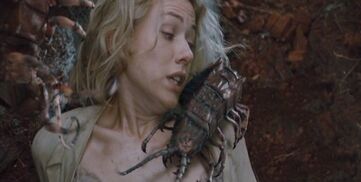|
Megapede dereponecis
| |
|
Name:
|
Megapede dereponecis
|
|
Abilities and Weapons:
|
jaws, venom, armour, size
|
|
Occupation:
|
Ambush mesopredator
|
|
Home:
|
Skull Island
|
|
First Appearance:
|
"King Kong" (from 2005)
"The World of Kong: A Natural History of Skull Island" (from 2005) |
|
Diet:
|
Carnivore
|
|
Size:
|
Length: 0.9-1.5 meters
Weight Estimated: 4.2-6 kilograms |
|
Status:
|
Unknown. Presumably rescued by expeditions.
|
Megapede Dereponecis (meaning "creeping-death giant-feet"), are 3-5 feet long (0.9-1.5 meters) species of Megapede.
Facts[]
Megapede dereponecis were the largest terrestrial centipede/myriapod species to have ever lived since Arthropleura, although Hydruscimex was larger overall. Because of this, they were too heavy to climb trees, and thus they hunted in their roots for hatchling dinosaurs which they immobilized with their venom.
Females chewed tunnels into rotting logs and laid their eggs inside them. They then grew extremely territorial of the log and attacked anything that may have threatened their young.
Like all megapedes, M. dereponecis was stockier and heavier than the more slender Idolon genus. However, whilst their jaw strength was formidable, their venom contents is predictably more muted than the Idolon genus.
In the Film[]

A Megapede dereponecis on Ann's shoulder
Two M. dereponecis was seen emerging from the hollow log that Ann Darrow was hiding from the Foetodon attack. Disturbed by the ruckus, these curious arthropods was examining Ann, before Ann freaked out and threw them off her body and emerged from the other end of the log.
In the Game[]
They are drastically increased in size to about 3 metres, and are one of the enemies Jack faces. They seem to be more based on Hydruscimex, not only in size, but also the fact they can swim. In the level Necropolis, many are scattered in the caves of Skull Island, one Megapede notoriously attacks and attempts to feast on Carl before Jack kills it.
Trivia[]
- Like all animals from Skull Island. It is unknown what they faced during the sinking of the island. Given the multiple expeditions, there may be a chance that a few surviving populations was saved off-land to a more stable enclosure.


